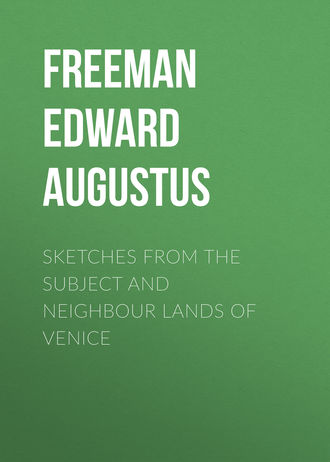 полная версия
полная версияПолная версия
Sketches from the Subject and Neighbour Lands of Venice
Whatever was the first origin of Tergeste, whoever, among the varied and perplexing inhabitants of this corner of the Hadriatic coast, were the first to pitch on the spot for a dwelling-place of man, it is plain that it ranks among the cities which have grown up out of hill-forts. Trieste in this affords a marked contrast to Marseilles, as it supplies a marked analogy to Cumæ and Ancona. The site of the Phôkaian settlement marks a distinct advance in civilization. The castellieri, the primitive forts, in the neighbouring land of Istria, were, according to Captain Burton, often made into places of Roman occupation, and something of the same kind may have been the case with Tergeste itself. The position of the cathedral church, occupying the site of the capitol of the Roman colony, shows of itself that Tergeste was thoroughly a hill-city. It has spread itself downwards, like so many others, though this time, not into the plain, but towards the sea. Standing on the border-land of Italy and Illyria, its destiny has been in some things the same as that of its neighbours, in others peculiar to itself. It must not be forgotten that, setting aside the coast cities, the land in which Trieste stands has for ages been a Slavonic land, except so far as it is also partly a Rouman land. How far the Italian and the Rouman elements may have been originally the same, is a puzzling question on which it would be dangerous to enter here. But one thing is certain, that, if the present inhabitants of the Tergestine city had obeyed the call of Garibaldi, "Men of Trieste, to your mountains," they would have found Slavonic possessors claiming those mountains by the strongest of all titles. For we have now distinctly passed the national border. We have come to the lands where the body is Slavonic, where the Italian element, greater or smaller, is at most only a fringe along the coast. Tergeste with the neighbouring lands formed part of the dominion of Theodoric and of the recovered Empire of Justinian; but it never came under the rule of the Lombard. Its allegiance to the lords of Constantinople and Ravenna, lords whose abiding power in this region is shown in the foundation of the Istrian Justinopolis, lasted unshaken till the Frank conquest, when Tergeste became part of the Italian kingdom of the Karlings. From that time to the fourteenth century, its history is the common history of an Italian city. It is sometimes a free commonwealth, sometimes subject to, or claimed by, the Patriarch of Aquileia or to the Serene Republic itself. By the treaty of Turin in 1381, the independence of the commonwealth of Trieste was formally acknowledged by all the contending powers. The next year the liberated city took the seemingly strange step of submitting itself to the lordship of a foreign prince. Leopold, Duke of Austria, he who died at Sempach, he to whom Venice resigned Treviso, was received by a solemn act as Lord of Trieste, and that lordship passed on to the Dukes, Archdukes, Kings, and Emperors of his house, and from them to their Lotharingian successors. Thus, unlike Treviso and Udine, Trieste has been Austrian in one sense only. Never forming a part of the Austria of Lombardy, it has had a far more abiding connexion with the Austria of Germany. The lordship which Trieste acknowledged was of course at first only an overlordship, and the Council and Commons of the city still continued to act as a separate commonwealth. But an union of this kind is one of those fatal partnerships between the stronger and the weaker which can lead only to bondage. Trieste has ever since remained Austrian in allegiance, save during the chaos of the days of the elder Buonaparte. Those days are commemorated by an inscription on the duomo, which tells of the expulsion of the French from the castle by an allied force, whose name of "Austro-Angli" might almost suggest some unrecorded tribe in our own island.
It is certainly hard to conceive a building more uninviting without than the cathedral church of Saint Justus. But Sokratês was not to be judged by his outside, neither is the duomo of Trieste. A broad and almost shapeless west front is flanked by a low, heavy tower, not standing detached as a campanile, as it should stand in Italy, not worked into the church as it would be worked in England or Germany, but standing forward in a kind of Scotch fashion, like Dunkeld. The only architectural feature seems to be a large wheel window, which it would be unfair to compare to that of Saint Zeno. But the next moment will show, built in at the angle of the church and the tower, a noble fluted column with its half-defaced Corinthian capital, which is enough to show what has been. We are carried back to Rome, to Saint Mary in Cosmedin and Saint Nicolas in Carcere, as we trace out in the lower stage of the tower the remains of the temple of Jupiter which has given way to the church of Justus. Imbedded in its walls are pilasters, columns, and their basement, showing that Jupiter of Tergeste must have lifted his pillared portico above the sea as proudly as Aphroditê of the Doric Ankón. Fragments of entablatures, trophies, sepulchral monuments, are built up in the wall. The western doorway of the church is made out of a huge tomb of the Barbii – a gens which we do not elsewhere remember – deliberately cut in two, and set up the wrong way. The building or rebuilding of the tower in 1337 is commemorated by an inscription in letters of that date – "Gothic" letters, as some call them – out of a mutilated part of which the earlier Tergestine antiquaries spelled out that the tower was rebuilt, in 556, after a destruction by the Goths. As the letters ..LVM.. were enough to create the new saint Philumena, the letters ..OT… could easily be filled up into "a Gothis eversa" – quite evidence enough to lead a zealous Italian to lay the destroying deeds of his own forefathers on the Gothic preservers of the works of the elder day.
As soon as we pass the doorway with the heads of the Barbii on either side, we forget the wrongs alike of Jupiter and of the Goths. The wonderful interior of the double basilica opens upon us. The first feeling is simply puzzledom. A nave of vast width seems to be flanked by two ranges of columns on either side, columns varying even more than is usual in their height and in the width of the arches which they support. When we look within the two lateral ranges, we are not surprised to find each ending in an apse with a noble mosaic; we are surprised to find the southern range interrupted by a cupola. This last phænomenon will help us to the explanation of the whole mystery. The church is in fact two churches thrown into one. When they were distinct, they must have stood even nearer than the old and new minsters at Winchester; indeed a plan in a local work shows, with every probability, their walls as actually touching in one point. The northern church was a basilica of the ordinary type, made up of columns – some of them of very fine marble – put together, as usual, without much regard to uniformity. All bear Corinthian capitals of different varieties, and all carry the Ravenna stilt in a rude form without the cross. The wall rose high above the arcade, and was pierced with a range of narrow clerestory windows, but with nothing else to relieve its blankness. This church the Tergestine antiquaries attribute, but, as far as we can see, without any direct evidence, to the reign of Theodosius. The southern church is, in its original parts, the same in style as the northern, but it is much smaller and, in its plan at least, thoroughly Byzantine. It was a small cross church, with a central cupola, and its north transept seems to have touched the south aisle of its northern neighbour. It is perhaps on the strength of the plan that the church is assigned to the reign of Justinian. But there is nothing Byzantine in the details; where the original capitals remain, they are of the same somewhat rude Corinthian character as those in the northern church; they have the same stilt, and under the cupola there is even a bit or two of entablature built up again. But the building went through much greater changes than the northern church did in the work of throwing the two into one whole. The date of this change seems to be fixed by a consecration recorded in the local annals in 1262. The south aisle of the northern church, the north aisle and north transept of the southern one, were pulled down, and the space which they had covered was roofed in to form the nave of the united building, while the two earlier basilicas sank into the position of its aisles. In the northern church this involved no change beyond the disappearance of the south aisle and the blocking of its clerestory; the smaller church to the south had to suffer far more. It had to be raised and lengthened; a quadrangular pier on the south side marks the original length, and the increase of height of course destroys the proper effect of the cupola. Then, as the cupola of course rested on columns with wider arches, its northern arch was filled up with two smaller arches and an inserted column, so as to make something like a continuous range. Still, late in the thirteenth century, they again used up the old marble columns; but they now used a flat capital, by which the additions of this time may be distinguished from the genuine basilican work.
Probably no church anywhere has undergone a more singular change than this. It is puzzling indeed at first sight; but, when the key is once caught, the signs of each alteration are so easily seen. The other ancient relic at Trieste is the small triumphal arch. On one side it keeps its Corinthian pilasters; on the other they are imbedded in a house. The arch is in a certain sense double; but the two are close together and touch in the keystone. The Roman date of this arch cannot be doubted; but legends connect it both with Charles the Great and with Richard of Poitou and of England, a prince about whom Tergestine fancy has been very busy. The popular name of the arch is Arco Riccardo.
Such, beside some fragments in the museum, are all the remains that the antiquary will find in Trieste; not much in point of number, but, in the case of the duomo at least, of surpassing interest in their own way. But the true merit of Trieste is not in anything that it has in itself, its church, its arch, its noble site. Placed there at the head of the gulf, on the borders of two great portions of the Empire, it leads to the land which produced that line of famous Illyrian Emperors who for a while checked the advance of our own race in the world's history, and it leads specially to the chosen home of the greatest among them. The chief glory of Trieste, after all, is that it is the way to Spalato.
TRIESTE TO SPALATO
TRIESTE TO SPALATO
1875Given such weather as suits fair-weather sailors, there can hardly be any enjoyment more thoroughly unmixed than a sail along the coast of Dalmatia. First of all, there is a freshness about everything. Here is a portion of land which is thoroughly unhackneyed; the coasts, the islands, the channels, of Dalmatia are as yet uninvaded by the British tourist. No Cook's ticket can be taken for Spalato; no hotel coupon would be of the slightest use at Sebenico. The land is whatever its long and strange history, old and new, has made it. It has gone through many changes and it has put on many shapes, but it has escaped the fate of being changed into a "playground of Europe."
The narrow strip of land on the eastern side of the Hadriatic on which the name of Dalmatia has settled down has a history which is strikingly analogous to its scenery. A coast for the most part barren and rocky, but with its barrenness and rockiness diversified by a series of noble havens, is fenced off by a range of mountains from a boundless inland region. Each of these havens, with the cities which from early days have sprung up on each, has always been an isolated centre of civilization in a backward land. As a rule, broken only during a few centuries of the universal sway of Rome, the coast and the inland country have been the possession, by no means always of different nations, but most commonly of different governments. On the coast the rule of the Venetian has been succeeded by the rule of the Austrian, while in the inland region the rule of native Slavonic princes has been succeeded by the rule of the Turk. Yet the Slave, though an earlier settler than the Turk or the Venetian, was himself only a settler in comparatively recent times. Native Illyrians, Greek colonists, Roman colonists, the rule of the Goth from Ravenna, the rule of the Eastern Roman from Constantinople, had all to take their turn before the land put on its present character of a more or less Italianized fringe on a Slavonic body, of a narrow rim of Christendom hemming in the north-eastern conquests of the once advancing and now receding Mussulman.
So it is with Dalmatian history. As the cultivation and civilization of the land lies in patches, as harbours and cities alternate with barren hills, so Dalmatia has played a part in history only by fits and starts. This fitful kind of history goes on from the days of Greek colonies and Illyrian piracy to the last war between Italy and Austria. But of continuous history, steadily influencing the course of the world's progress, Dalmatia has none to show. Salona plays its part in the wars both of Cæsar and of Belisarius; Zara reminds us of the fourth crusade; the whole history of Ragusa claims a high place among the histories of independent and isolated cities; Lissa recalls the memory of two times of warfare within our own century. But if there was any time when Dalmatia really influenced the history of the world, it was when Dalmatia had no national being, when it was merely a province of an universal dominion along with Britain and Egypt. Of the great Emperors of the third century, who called the Roman power into new life and checked the ever-advancing wave of Teutonic invasion, many came from the Illyrian lands, several came from the actual Dalmatian coast. And the most famous among them – Docles, Diocletian, Jovius – not only came forth from Dalmatia to rule the world, but went back to Dalmatia to seek rest when weary of the toil of ruling it.
But in our immediate point of view we must never forget that our course now lies wholly, not only by subject lands of Venice, but by lands where Venice appears in her highest character as the bulwark of Christendom against the misbeliever. The shores and cities by which we pass, were subject to the Serene Republic, but subjection to the Serene Republic was their only chance of escaping subjection to the Ottoman Sultan. Every town, every fortress, almost every point of ground along this whole coast, has been fought for, most of them have been won and lost, over and over again, in the long crusade which Venice waged, if for herself, yet for Europe also. Her rule was an alien rule, but it was still European and Christian; it shut out the rule of the barbarian. It was a rule better and worse in different times and places, but it had always the merit of shutting out a worse rule than itself, which was ever ready to take its place. Whenever we see the winged lion keeping guard, the thought should rise that he kept guard over spots which he alone kept for Christendom, which he alone saved from barbarian bondage.
The visitor to Dalmatia may be conceived as setting forth from the harbour of Trieste – from Trieste with its houses climbing up to the church and castle on the hill, with the background of mountains growing in the far distance into snowy Alps. From the Dalmatian coast itself no snowy Alps are seen; but the whole land is only a mountain slope, and the cities are cities on a smaller scale than Trieste, and which seldom run so high as Trieste does up the hill-side. But we must not forget that, even at Trieste, Dalmatia is still a distant land. There is the Istrian peninsula to be skirted, the peninsula whose coast was so long counted among the subject lands of Venice, while the inland region, under the rule of counts of Gorizia and dukes of Austria, counted only among the neighbours of the Republic. The Istrian coast, largely flat, is marked here and there by small towns standing well on high points over the sea, or seen more faintly in the more distant inland region. But we know that inland Istria is a hilly land, and, even from the sea, the mountain wall may still be seen skirting the horizon. Darkness has come on by the time we reach the harbour of Pola, once Pietas Julia, now the chief station of the infant navy of Austria. But the darkness is not so great but that the dim outline of the vast amphitheatre can be seen, and the arrangements of the Austrian Lloyd's steamers allow time enough to go on shore and take in the general effect both of the amphitheatre and the other buildings of Pola. We here get our first impression of the Venetian towns beyond the Hadriatic, all of which seem to attempt in some sort to reproduce their mistress, so far as Venice can be reproduced where there are no canals and therefore no gondolas. But all have the same narrow, paved streets, the same little squares, and, if the passage of horses and wheels is not so utterly unknown as it is at Venice, their presence is, to say the least, rare. The lion of Saint Mark is to be seen everywhere else; by daylight therefore he is to be seen at Pola also. But the Lloyd's arrangements condemn Pola, in the early part of October at least, to be seen only by dim glimpses, while Zara has an ample measure of daylight. Let no one however blame a time-table which will bring him into Spalato with the setting sun, and will allow him to take his first glance of Diocletian's palace by the rising moon.
In the night we pass by several islands, but none are of any historic importance. Veglia lies out of our path, or we might muse on the evil deeds of the last independent Count, at least as they were reported by his Venetian enemies, who were eager to get possession of his island. The tale will be found in Sir Gardner Wilkinson's "Dalmatia and Montenegro," a book which no traveller in these lands should be without. The next morning's light shows us genuine Dalmatia, its coast at this stage marked by the barren hills coming down to the sea and the range of higher mountains further inland. We skirt among endless islands, most of which seem barren and uninhabited; we pass along the channel of Zara, and come to anchor off the city itself, standing on its peninsula crowned with its walls – Venetian and later – and with the towers of its churches rising above them. Here a stay of several hours allows a pretty full examination of our first Dalmatian city – a city however more Italian and far less thoroughly Dalmatian than other cities to which our further course will lead us. There is time to visit the duomo and the smaller churches – to mark the two surviving Roman columns – to thread the narrow streets, with their occasional scraps of Venetian architecture – to stroll by the harbour, under the gateways marked by the lion of Saint Mark, one of which so oddly proves to be really a Roman gate with a Venetian casing. We may even, if we so think good, climb the mound which, though crowned by a not attractive Chinese pagoda, nevertheless supplies the best view of Zara and her two seas. The Albergo al Cappello– the sign of the Hat – supplies food certainly not worse than an Italian town of the same class would set before a passing traveller. The meal done, to sit out of doors in a café is nothing new to any one who has crossed the straits, not of Zara but of Calais; but it is a new feeling to do so in the narrow streets of a Dalmatian town, and to add the further luxury of maraschino drunk in its native land.
Night is now passed on board, and Zara is left by sunrise. Islands and hills again succeed on either side, till we enter a narrow strait and find ourselves in a noble harbour with a town in front, lying, like most Dalmatian towns except Zara, at the foot of the mountains. We are in the haven of Sebenico, but the haven of Sebenico is by no means the whole of the inlet, which runs much further inland in the shape of a narrow creek. We land, and give such time as is allowed us to a sight of the little hill-side city. Shall we give Sebenico the last place among the cities which we stay and examine in detail, or the first place among the lesser cities to which we give such time as we can in passing by? We are driven to this last course, not forgetting, if we are minded to turn away from history and art to look for a while on a striking natural object, that it is from Sebenico that we may best make our way to the great waterfall of Kerka. And, as far as those who have made no special study of Alpine matters may speak, the falls of Kerka, rushing down in a company of torrents side by side, look as if they had a right to take a high place among the falls at least of the old world. But Sebenico is not simply the way to Kerka; there is something to see in Sebenico itself. It is a hill city, but it is emphatically not a hill-top city, but a hill-side city. We climb up through the inhabited town to the castle, and when we reach the castle, we are far from having reached the hill top. And to those who make Sebenico their second halting-place on the strictly Dalmatian coast it will have a special interest. Much smaller than Zara, it is far more thoroughly Dalmatian; costume is more marked, and its position gives it that peculiar air of quaintness which is shared by all places where narrow streets run up a steep hill. And those streets moreover are rich with architectural features, graceful windows and the like, which witness to the influence of the ruling city. And there is something not a little taking in the small piazza of Sebenico – the arcaded loggia on the one side, the cathedral on the other, with its mixed but stately architecture, its waggon-roof of stone standing out boldly without either buttress or external roof. Mr. Neale, whom, as he does not rule Sebenico to be a "church city," we may now quote seriously, holds that the cathedral of Sebenico is "in an exclusively architectural view the most interesting church in Dalmatia." He adds that "in truth it is one of the noblest, most striking, most simple, most Christian of churches." This is high praise, especially when bestowed by Mr. Neale on a church which was consecrated so lately as 1555. But there is no denying that, strangely confused as is its style, the church of Sebenico is, both inside and out, not only a most remarkable, but a thoroughly effective building. The internal proportions are noble; the height is great; the columns, though their arches are pointed, might have stood in any basilica at Rome or Ravenna; the barrel vaulting carries us away to Saint Sernin at Toulouse and to the Conqueror's Tower. The details are a strange mixture of late Gothic and Renaissance, very rich and somehow very effective. It is not exactly like that class of French churches of which Saint Eustache at Paris is the grandest example, where a thoroughly mediæval outline is carried out with Renaissance detail. At Sebenico we see side by side, a bit in one style and a bit in the other, and yet the two contrive to harmonize. We go down again to the haven; we mark a few classical capitals preserved, as we here preserve ammonites and pieces of rock-work; we start again to make the second portion of our second day's voyage, and to reach the most marked and memorable spot in our whole course.
After Sebenico the coast is for a while almost free from islands. Presently we pass along among a few small ones, and Lissa, famous for piracies two thousand years back and for more regular warfare in our own century and in our own day, shows itself in the distance. Our course has by this time turned nearly due east. We pass by Bua, hardly conscious that it is an island. We pass by the mouth of the bay which Bua guards, hardly conscious of the depth of the inlet into which it leads, or that two cities – Traü and fallen Salona – are washed by its waters. For the child of Salona, the great object of a Dalmatian voyage, is coming within sight far away. The mighty campanile of Spalato rises, kindled with the last rays of sunlight; presently the cupola of the metropolitan church, the long line of the palace wall, the buildings of what is plainly no inconsiderable city, stand out against their mountain background. The sun has gone down behind the western headland, but we can get our first glimpse of the city, its arcades and tower and temples, by that moonlight which is as good at Spalato as at Melrose. We have been in the home of Diocletian, and we go back to our ship, for the next day to bring us to the one city along these shores which the might of Venice could never bring into subjection.









